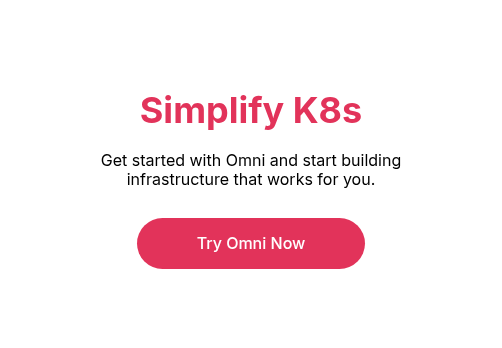Survive the crunch: Reduce Kubernetes costs without compromising speed

Teams managing Kubernetes are under pressure. Budgets are frozen. Headcounts are shrinking. And yet, infrastructure still has to scale.
According to the Engineering Leadership Report, 65% of engineers and managers have taken on expanded responsibilities. Only 3% saw their workload decrease. That kind of shift leads to burnout, risk, and growing technical debt. If you’re managing Kubernetes right now, you likely feel the crunch too.
Leaders know incremental tooling won’t fix these problems. To survive the pressure and protect delivery, teams must remove the unnecessary work that surrounds Kubernetes and rethink what should be manual at all. Omni changes the way your team understands and works with Kubernetes clusters.
Top causes of Kubernetes team burnout
Upgrades, unexpected drift, and other repetitive tasks are high on the list. Most Kubernetes environments are built on custom scripts, manual processes, and constant patching, leading to hours spent on basic tasks just to keep the machine running.
How many hours does your team spend on upgrades in a term? What about cluster management and provisioning? Common time drains include:
- Tracking component updates and managing upgrades across environments
- Chasing config drift and recovering from silent failures
- Applying CVE patches
- Repeating OIDC setup and provisioning cluster access
- Building and maintaining one-off scripts for clusters
These tasks are routine, but they add up. They increase the risk of outages, burnout, and security gaps while creating bottlenecks that only “that one engineer” knows how to fix. At scale, they consume thousands of dollars in engineering time every quarter and take time away from working on products.
Here’s an example. For many, a single cluster upgrade takes 6-8 hours across environments, with drift detection and correction adding 10 hours a week across the team. Multiply that by four engineers, and you’ve just spent 160 hours in a month not delivering features. If your average engineering salary is $100/hour, that’s $16,000 to stay afloat.
When pressure mounts to cut costs, most teams reach for the wrong levers. They choose more dashboards rather than reducing the number of problems. They build more automation on top of fragile foundations. They work to cut cloud bills and reduce the Kubernetes maintenance burden one small, painful step at a time.
Times have changed. Cloud optimization won’t save your budget. Noteworthy cost savings come from reducing the overall Kubernetes operational complexity.
Cutting Kuberentes costs demands more than a few best practices
Omni is the multi-local cluster management platform that changes the Kubernetes operating model. Instead of piling on automation tools, it removes categories of toil through simplicity, immutability, and built-in best practices, making bare metal and edge as easy as managed Kubernetes.
| Without Omni | With Omni | |
| Provisioning | Multi-step scripts and bootstrapping. | A few clicks and it’s up in minutes. |
| Lifecycle management | Manual patching, multi-tool upgrade flows. | Simple and centralized upgrades and rollback control. |
| Access control | Repeat OIDC and RBAC setup per cluster. | Configure once, apply everywhere. |
| Security | Hardened images, bolt-on tools, audit layers. | Secure-by-default infra free from shell, SSH, or package manager. SBOM-backed, and comes with critical security features you need. |
With Omni, your infrastructure becomes declarative and API-driven out of the box, whether you use the UI, CLI, or GitOps. Omni is powered by Talos Linux, a minimal, immutable Kubernetes OS. No more SSH or manual tweaks that lead to config drift in Day 2 operations. This is how Hathora went fully hybrid, saving millions of dollars.
Rather than focusing on quick changes, this reduces operational overhead at the foundation and removes the need for constant babysitting. Omni users get the “it just works” Kubernetes experience, leading to less burnout and far more productive teams. This makes it ideal for small teams, those with limited resources, or working with bare metal.
Omni and Talos Linux are simple, and that enables us to keep our pricing simple and predictable, too. One node = one fixed cost, capped at $1.2K per node per year–and that’s the enterprise-grade option. Here’s a closer look at how Omni saves you money.
Kubernetes efficiency at scale without burnout
Economic pressure demands lean operations, but that doesn’t mean sacrificing stability or burning out your team. See how many hours (and team members) you can free up. Try Omni and see what Kubernetes looks like without the constant maintenance drag.


 Spencer Smith
Spencer Smith